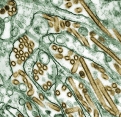
North American Bird Flu Strain Properties Could Enhance Infection Potential
The Centers for Disease Control and Prevention recently released results of a study suggesting that some North American avian influenza A H7 virus strains have properties that might enhance their potential to infect humans as well as their potential to spread from human to human. The study was recently published in the Proceedings of the National Academy of Sciences USA.
According to CDC, avian influenza A H7 viruses are fairly common in birds, but rarely infect humans. Most cases of avian influenza infection in humans have resulted from contact with infected poultry or contaminated surfaces.
"We know that influenza viruses are constantly changing and that is why it's so important to watch them carefully," said Jessica Belser, CDC lead author on the project. "In this study, we discovered that some recently identified avian influenza A H7 viruses have some properties that could enhance their potential to infect people and possibly spread among people."
Influenza viruses infect humans by attaching to certain sugar receptor molecules found on cells in the respiratory tract in humans. Influenza viruses can have differing degrees of ability to bind to these receptors. The greater an influenza virus' ability to bind to these receptors, the greater the likelihood that the virus can cause illness in humans and possibly be passed from human to human.
Three recent H7N2 strains and two H7N3 strains from North America were tested and found to bind to varying degrees to both avian and human receptors. One virus, an H7N2 virus strain isolated from an immune compromised man in New York in 2003, was found to have the greatest binding to the human sugar receptors. This study's findings suggest that these North American avian influenza A H7 viruses are partially adapted to recognize sugar receptors preferred by human influenza viruses which are found in the human upper respiratory tract.
"The results of this study underscore the importance of continued influenza virus surveillance," Belser said.
CDC said health officials have also been closely monitoring a different avian influenza virus, H5N1, which began spreading among birds and poultry in Asia in 2003 and has spread to birds in other countries in Europe, the Near East, and Africa. Nearly 400 human cases of H5N1 have been reported world-wide though none of these have occurred in the United States or even the Northern Hemisphere. Most of these cases have occurred from direct or close contact with infected poultry or contaminated surfaces; however, a few cases of human-to-human spread of H5N1 virus have occurred.
For more information on avian influenza, visit www.cdc.gov/flu/avian.